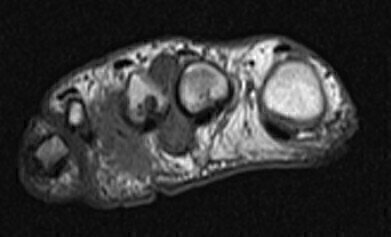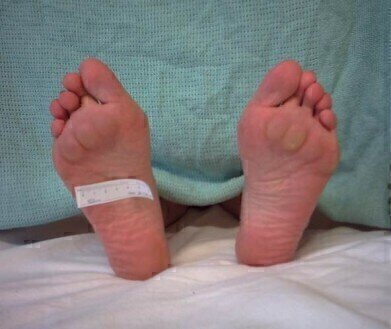-
 Inflamed bursae of the feet (Credit:University of Southampton)
Inflamed bursae of the feet (Credit:University of Southampton) -
 Inflamed bursae of the feet (Credit:University of Southampton)
Inflamed bursae of the feet (Credit:University of Southampton)
News
Researchers aim to improve outcomes of patients with RA in feet
Jan 23 2013
Researchers at the University of Southampton are undertaking a new stage of a study aimed at improving the health and mobility of those suffering from the common complaint of ‘walking on marbles’ associated with Rheumatoid Arthritis (RA) in the feet.
The Health Sciences’ FeeTURA study has developed new ways of assessing the forefeet through the use of diagnostic ultrasound and magnetic resonance imaging techniques. From this work, the team discovered that some of the swellings and associated feeling of ‘walking on marbles’ were related to inflamed bursae (a fluid-filled sac usually found in areas subject to friction) that had developed underneath the forefoot joints. These inflamed bursae were rarely detected by clinical examination.
The exact cause of the inflamed bursae is not known and a cure is yet to be found, however, the team is now looking at identifying inflammatory and mechanical markers to find the best ways of treating this complication in people suffering with RA. They will evaluate foot health treatments, such as targeted steroid injections, as well as medical management through the use of new drugs (biologics).
Led by senior lecturer for Advanced Clinical and Expert Practice, Dr Catherine Bowen, this new stage of the treatment study will be carried out by clinical academic researcher, Lindsey Hooper, who recently won a prestigious special award from Wessex HIEC for the previously completed MRI work.
It will be funded through a partnership between Solent NHS Trust and the Faculty of Health Sciences at the University of Southampton and supported by a National Institute for Health Research (NIHR) clinical academic fellowship.
Researchers at the University of Southampton are undertaking a new stage of a study aimed at improving the health and mobility of those suffering from the common complaint of ‘walking on marbles’ associated with Rheumatoid Arthritis (RA) in the feet.
The Health Sciences’ FeeTURA study has developed new ways of assessing the forefeet through the use of diagnostic ultrasound and magnetic resonance imaging techniques. From this work, the team discovered that some of the swellings and associated feeling of ‘walking on marbles’ were related to inflamed bursae (a fluid-filled sac usually found in areas subject to friction) that had developed underneath the forefoot joints. These inflamed bursae were rarely detected by clinical examination.
The exact cause of the inflamed bursae is not known and a cure is yet to be found, however, the team is now looking at identifying inflammatory and mechanical markers to find the best ways of treating this complication in people suffering with RA. They will evaluate foot health treatments, such as targeted steroid injections, as well as medical management through the use of new drugs (biologics).
Led by senior lecturer for Advanced Clinical and Expert Practice, Dr Catherine Bowen, this new stage of the treatment study will be carried out by clinical academic researcher, Lindsey Hooper, who recently won a prestigious special award from Wessex HIEC for the previously completed MRI work.
It will be funded through a partnership between Solent NHS Trust and the Faculty of Health Sciences at the University of Southampton and supported by a National Institute for Health Research (NIHR) clinical academic fellowship.
Digital Edition
Lab Asia Dec 2025
December 2025
Chromatography Articles- Cutting-edge sample preparation tools help laboratories to stay ahead of the curveMass Spectrometry & Spectroscopy Articles- Unlocking the complexity of metabolomics: Pushi...
View all digital editions
Events
Jan 21 2026 Tokyo, Japan
Jan 28 2026 Tokyo, Japan
Jan 29 2026 New Delhi, India
Feb 07 2026 Boston, MA, USA
Asia Pharma Expo/Asia Lab Expo
Feb 12 2026 Dhaka, Bangladesh


















